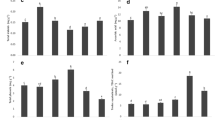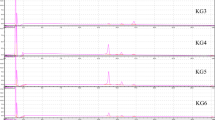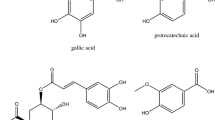Abstract
Use of gallic acid (GA) as a standard in the Folin-Ciocalteu assay leads to an underestimation of phenol content in persimmon extracts so does the widely used catechin (C) in vanillin assay for determining condensed tannins in persimmon extracts. To develop suitable standards for addressing the issue of accuracy, we prepared highly purified persimmon tannin (PT) and its three fractions (PT20, PT40 and PT60), as well as three characteristic structural subunits of PT including epicatechin-3-gallate-(4β → 8, 2β → O→7)-epicatechin-3-gallate (A-type ECG dimer), epigallocatechin-3-gallate-(4β → 8, 2β → O→7)-epigallocatechin-3-gallate (A-type EGCG dimer) and epicatechin-(4β → 8)-epicatechin (B-type EC dimer). We compared the color yield of commercially available standards including the dimers GA, EGCG, ECG, C and PT and its three fractions in the Folin-Ciocalteu assay and vanillin assay, respectively. Our results suggested that for estimating phenol content in persimmon extracts, EGCG, ECG, C and GA were poor standards in Folin-Ciocalteu assay. We recommended PT40 as the most suitable standard in determining the phenol content of persimmon extracts. In the vanillin assay, A-type EGCG dimer or A-type ECG dimer were superior than the commonly used C as standards, and ECG was also an alternative when A-type EGCG dimer or A-type ECG dimer were not available.



Similar content being viewed by others
References
Tian Y, Zou B, Yang L, Xu S-f, Yang J, Yao P, Li C-m (2011) High molecular weight persimmon tannin ameliorates cognition deficits and attenuates oxidative damage in senescent mice induced by d-galactose. Food Chem Toxicol 49(8):1728–1736
Tian Y, Zou B, Li C-m, Yang J, Xu S-f, Hagerman AE (2012) High molecular weight persimmon tannin is a potent antioxidant both ex vivo and in vivo. Food Res Int 45(1):26–30
Jang I-C, Jo E-K, Bae M-S, Lee H-J, Jeon G-I, Park E, Yuk H-G, Ahn G-H, Lee S-C (2010) Antioxidant and antigenotoxic activities of different parts of persimmon (Diospyros kaki cv. Fuyu) fruit. J Med Plant Res 4(2):155–160
Borges-Argaez R, Canche-Chay CI, Pena-Rodriguez LM, Said-Fernandez S, Molina-Salinas GM (2007) Antimicrobial activity of Diospyros anisandra. Fitoterapia 78(5):370–372
Gorinstein S, Kulasek GW, Bartnikowska E, Leontowicz M, Zemser M, Morawiec M, Trakhtenberg S (1998) The influence of persimmon peel and persimmon pulp on the lipid metabolism and antioxidant activity of rats fed cholesterol. J Nutr Biochem 9(4):223–227 0955-2863
Kondo S, Yoshikawa H, Katayama R (2004) Antioxidant activity in astringent and non-astringent persimmons. J Hortic Sci Biotech 79(3):390–394 1462-0316
Zou B, C-m Li, J-y Chen, X-q Dong, Zhang Y, Du J (2012) High molecular weight persimmon tannin is a potent hypolipidemic in high-cholesterol diet fed rats. Food Res Int 48(2):970–977
Fukai S, Tanimoto S, Maeda A, Fukuda H, Okada Y, Nomura M (2009) Pharmacological activity of compounds extracted from persimmon peel (Diospyros kaki THUNB.). J Oleo Sci 58(4):213–219
Lee SO, Chung SK, Lee IS (2006) The antidiabetic effect of dietary persimmon (Diospyros kaki L. cv. Sangjudungsi) peel in streptozotocin induced diabetic rats. J Food Sci 71(3):S293–S298 1750-3841
Park YS, Leontowicz H, Leontowicz M, Namiesnik J, Jesion I, Gorinstein S (2008) Nutraceutical value of persimmon (Diospyros kaki Thunb.) and its influence on some indices of atherosclerosis in an experiment on rats fed cholesterol-containing diet. Adv Hortic Scie 22:250–254
Hagerman AE, Butler LG (1994) Assay of condensed tannins or flavonoid oligomers and related flavonoids in plants. Methods Enzymol 234:429–437
Feliciano RP, Shea MP, Shanmuganayagam D, Krueger CG, Howell AB, Reed JD (2012) Comparison of isolated cranberry (Vaccinium macrocarpon Ait.) proanthocyanidins to catechin and procyanidins A2 and B2 for use as Standards in the 4-(dimethylamino) cinnamaldehyde assay. J Agric Food Chem 60(18):4578–4585
Schofield P, Mbugua DM, Pell AN (2001) Analysis of condensed tannins: a review. Anim Feed Sci Tech 91(1):21–40 0377-8401
Sun B, Belchior GP, Ricardo-da-Silva JM, Spranger MI (1999) Isolation and purification of dimeric and trimeric procyanidins from grape seeds. J Chromatogr A 841(1):115–121
Gu H-F, Li C-M, Xu Y-j, Hu W-f, Chen M-h, Q-h Wan (2008) Structural features and antioxidant activity of tannin from persimmon pulp. Food Res Int 41(2):208–217
Li C, Trombley J, Schmidt M, Hagerman A (2010) Preparation of an acid butanol standard from fresh apples. J Chem Ecol 36(5):453–460
Li CM, Leverence R, Trombley JD, Xu SF, Yang J, Tian Y, Reed JD, Hagerman AE (2010) High molecular weight persimmon (Diospyros kaki L.) proanthocyanidin: a highly galloylated, a-linked tannin with an unusual flavonol terminal unit, myricetin. J Agric Food Chem 58(16):9033–9042
S-f Xu, Zou B, Yang J, Yao P, Li C-m (2012) Characterization of a highly polymeric proanthocyanidin fraction from persimmon pulp with strong Chinese cobra PLA2 inhibition effects. Fitoterapia 83(1):153–160
Spranger I, Sun B, Mateus AM, Freitas Vd, Ricardo-da-Silva JM (2008) Chemical characterization and antioxidant activities of oligomeric and polymeric procyanidin fractions from grape seeds. Food Chem 108(2):519–532
Singleton VL, Orthofer R, Lamuela-Raventós RM (1999) Analysis of total phenols and other oxidation substrates and antioxidants by means of Folin-Ciocalteu reagent. In: Lester P (ed) Methods enzymol, vol 299. Academic Press, London, pp 152–178
Waterman PG, Mole S (1994) Analysis of phenolic plant metabolites, vol 83. Blackwell, New York
Hagerman AE (2002) Tannin analysis. www.users.muohio.edu/hagermae/
McMurrough I, McDowell J (1978) Chromatographic separation and automated analysis of flavanols. Anal Biochem 91(1):92–100
Prior RL, Fan E, Ji H, Howell A, Nio C, Payne MJ, Reed J (2010) Multi-laboratory validation of a standard method for quantifying proanthocyanidins in cranberry powders. J Sci Food Agr 90(9):1473–1478
Acknowledgments
This study was supported by the National Natural Science Foundation of China (No. 31271833), the Chinese Ministry Program for New Century Excellent Talents in University (NCET-12-0865) Special Fund for Agro-scientific Research in the Public Interest (No. 201203047) and Fundamental Research Funds for the Central Universities (2013PY022).
Conflict of interest
None.
Compliance with Ethics Requirements
This article does not contain any studies with human or animal subjects.
Author information
Authors and Affiliations
Corresponding author
Rights and permissions
About this article
Cite this article
Zou, B., Dong, Xq., Ge, Zz. et al. Development of suitable standards for quantitative determination of persimmon phenol contents in Folin-Ciocalteu and vanillin assays. Eur Food Res Technol 239, 385–391 (2014). https://doi.org/10.1007/s00217-014-2232-x
Received:
Revised:
Accepted:
Published:
Issue Date:
DOI: https://doi.org/10.1007/s00217-014-2232-x




